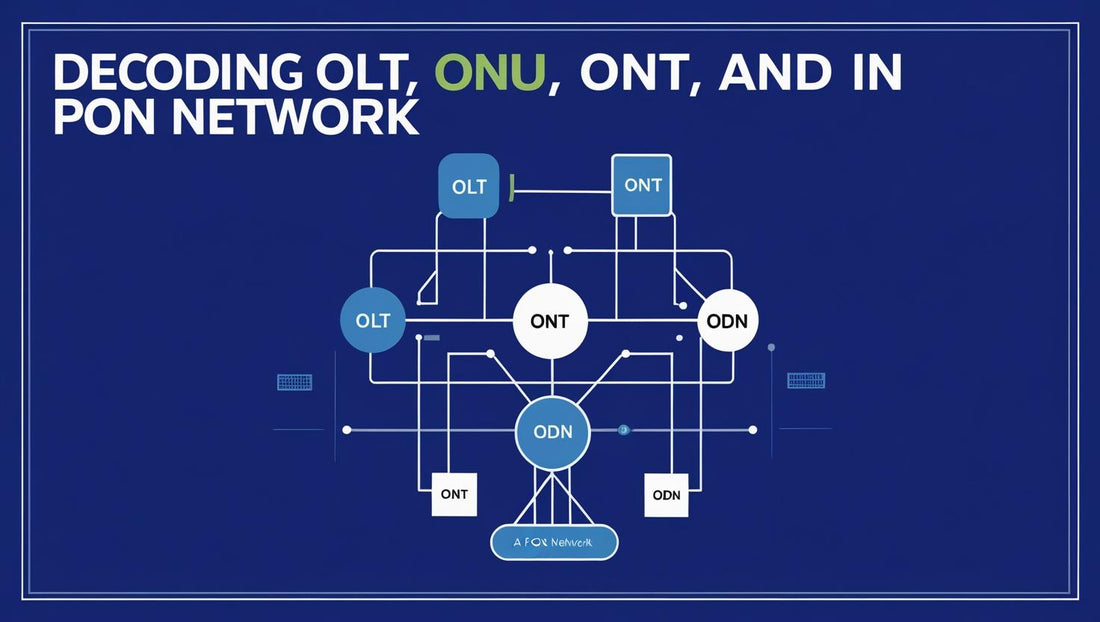
Decoding OLT, ONU, ONT, and ODN in PON Network|QSFPDD800G
OptechTWShare
Decoding OLT, ONU, ONT, and ODN in PON Network
As fiber-optic communication becomes the backbone of global internet infrastructure, Passive Optical Network (PON) technologies play a vital role. This article breaks down four core components of PON: OLT, ONU, ONT, and ODN, with a special focus on the Optical Line Terminal (OLT)—the brain of the network.
What is OLT (Optical Line Terminal)?
OLT is the central device located at the service provider’s central office. It is responsible for:
-
Signal conversion between electrical and optical formats.
-
Traffic control between the core network and the passive optical network.
-
Bandwidth allocation for each connected user.
-
Uplink aggregation, combining signals from multiple ONUs/ONTs.
An OLT typically supports multiple PON ports, with each port connecting to dozens of ONTs/ONUs via ODN.
ONU vs. ONT: What’s the Difference?
Though often used interchangeably, ONU (Optical Network Unit) and ONT (Optical Network Terminal) have subtle differences:
-
ONU: A broader term referring to customer-premises equipment that converts optical signals into electrical signals. Often used in business or distributed environments.
-
ONT: A type of ONU located at the end-user’s premises, usually a single-family home or small business.
ODN: The Passive Pathway
The ODN (Optical Distribution Network) is the passive portion of the network and consists of:
-
Fiber cables
-
Splitters
-
Connectors
ODN ensures that optical signals from the OLT are distributed evenly to each ONT/ONU without requiring active electrical components—hence “passive.”
The Role of OLT in PON Network Architecture
Core Network ←→ OLT ←→ ODN ←→ ONU/ONT ←→ End Users
-
OLT initiates and manages downstream communication to multiple endpoints.
-
Handles time-division multiplexing (TDM) for downstream and time-division multiple access (TDMA) for upstream.
-
Manages dynamic bandwidth allocation (DBA) to balance traffic demands.
Types of PON Technologies and OLT Support
| PON Standard | Downstream Rate | Upstream Rate | OLT Port Density |
|---|---|---|---|
| GPON | 2.5 Gbps | 1.25 Gbps | 8–16 ports |
| XG-PON | 10 Gbps | 2.5 Gbps | 4–8 ports |
| XGS-PON | 10 Gbps | 10 Gbps | 4–8 ports |
| NG-PON2 | 40 Gbps | 10 Gbps | 2–4 ports |
Modern OLTs are modular and support hot-swappable line cards, making upgrades and maintenance efficient.
OLT: The Heart of Scalable Fiber Infrastructure
The importance of OLTs goes beyond mere connectivity—they enable:
-
Scalability: One OLT can serve thousands of users via splitters.
-
Efficiency: Centralized control for traffic, authentication, and provisioning.
-
Cost savings: Passive ODN means fewer active components and lower maintenance.
Conclusion
Understanding OLT, ONU, ONT, and ODN is essential for grasping how modern fiber networks operate. Among these, the OLT is the cornerstone—ensuring seamless delivery of high-speed broadband, efficient bandwidth allocation, and robust network control.
Whether you’re deploying fiber-to-the-home (FTTH), fiber-to-the-business (FTTB), or rural broadband solutions, selecting the right OLT platform is critical to performance and scalability.
